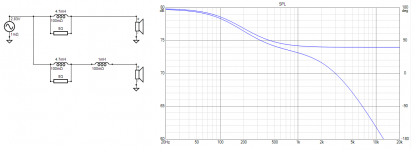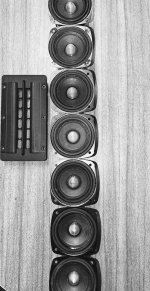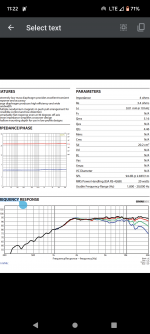You say sensitivity can be adjusted with shading, however it can also be adjusted with EQ. The question is, do you have a plan for directivity, and if not then why not just go ahead and add a tweeter and EQ it?
Sorry, that's (EQ) not an option for my system, which is a legacy system consisting of source(s), preamp, power amp with powered subwoofers (I use both tube and solid state). Lovely.
I had been using a pair of stand-mounted 6" two-ways, but got a bunch of these little 3" full-range drivers to try a line array (better dynamics).
I like the purity of a simple signal path, and am now on a strict budget (lost job during pandemic). Luckily I already had all the components and a workshop with table saw. And have time.
Any creative ideas for good implementation of adding a planar tweeter, using passive components for crossover (and baffle-step correction)?
Thanks,
- Charles
I had been using a pair of stand-mounted 6" two-ways, but got a bunch of these little 3" full-range drivers to try a line array (better dynamics).
I like the purity of a simple signal path, and am now on a strict budget (lost job during pandemic). Luckily I already had all the components and a workshop with table saw. And have time.
Any creative ideas for good implementation of adding a planar tweeter, using passive components for crossover (and baffle-step correction)?
Thanks,
- Charles
Last edited:
Sorry to confuse... EQ or passive crossover, I meant the same thing.. balancing the sound to where it should be.
Now I am learning about your needs. You want to add a tweeter, you want to compensate the baffle, you're not going to focus on directivity today and you prefer to do this without measuring.
Why not add a bracket for your tweeter. Don't make it too small, and sand back the edges.
Have you tried compensating a baffle with an inductor and a resistor? If not, I guess we could show a simulation as an example and throw in a crossover filter.
Now I am learning about your needs. You want to add a tweeter, you want to compensate the baffle, you're not going to focus on directivity today and you prefer to do this without measuring.
Why not add a bracket for your tweeter. Don't make it too small, and sand back the edges.
Have you tried compensating a baffle with an inductor and a resistor? If not, I guess we could show a simulation as an example and throw in a crossover filter.
Quote: "Have you tried compensating a baffle with an inductor and a resistor? If not, I guess we could show a simulation as an example and throw in a crossover filter"
That would be great.
I have tried a couple of the "baffle-step filter calculator" online, but would like to see your recommendation (my test baffle was 5" wide, but I'm working on a pair of 6.5" baffles with
rounded or chamfered edges (to reduce edge diffraction).BTW, does rounding or chamfering the baffle edge change the baffle-step at all?
Thanks,
Charles
That would be great.
I have tried a couple of the "baffle-step filter calculator" online, but would like to see your recommendation (my test baffle was 5" wide, but I'm working on a pair of 6.5" baffles with
rounded or chamfered edges (to reduce edge diffraction).BTW, does rounding or chamfering the baffle edge change the baffle-step at all?
Thanks,
Charles
Last edited:
Starting out with the basic circuit, not simulating with real driver data. This shows a way to do the baffle step, and then to add a filter to it. In both cases changing the inductor value changes the frequency.
It can smooth it. The frequency might change slightly but it doesn't go away.does rounding or chamfering the baffle edge change the baffle-step at all?
Attachments
Thanks.
I see in the lower half of your diagram there are TWO series inductors. It looks like the second is a low-pass filter at a higher frequency, affecting one of the two drivers shown.Can you clarify for me (Not exactly certain of how to use this with my 12 driver array)?
I was also wondering how best to cross over to a tweeter, if it is mounted adjacent to the line with a horizontal displacement of 5 to 6 inches from the centerline? Plus, freed from the restriction of baffle mounting, it looks like I can choose the more sensitive Dayton PT2 over the Emit, another benefit being its lower resonance frequency, simplifying the high pass filter...
Thanks,
-Charles
I see in the lower half of your diagram there are TWO series inductors. It looks like the second is a low-pass filter at a higher frequency, affecting one of the two drivers shown.Can you clarify for me (Not exactly certain of how to use this with my 12 driver array)?
I was also wondering how best to cross over to a tweeter, if it is mounted adjacent to the line with a horizontal displacement of 5 to 6 inches from the centerline? Plus, freed from the restriction of baffle mounting, it looks like I can choose the more sensitive Dayton PT2 over the Emit, another benefit being its lower resonance frequency, simplifying the high pass filter...
Thanks,
-Charles
Ok. I read more on the subject.
I see the parallel coil and resistor are the (6dB) baffle-step compensation for a baffle approximately 17" wide (just a generic example?).
The series coil is a low pass filter for a crossover of around 1.2kHz. -Am I close?
Which modeling program are you using? It looks like XSim, which I just recently downloaded, but not yet learned to use.
For now I guess I'll try about a 1.5mH // 7ohms and make a bracket to attach my tweeters to the side and see which one seems to blend best with a simple series cap up high.
May I still take any suggestions on how to proceed with a proper crossover?
Thanks
I see the parallel coil and resistor are the (6dB) baffle-step compensation for a baffle approximately 17" wide (just a generic example?).
The series coil is a low pass filter for a crossover of around 1.2kHz. -Am I close?
Which modeling program are you using? It looks like XSim, which I just recently downloaded, but not yet learned to use.
For now I guess I'll try about a 1.5mH // 7ohms and make a bracket to attach my tweeters to the side and see which one seems to blend best with a simple series cap up high.
May I still take any suggestions on how to proceed with a proper crossover?
Thanks
Last edited:
Anybody add tweeter to short line array?
I have a short line array of twelve 3" wide range drivers in a narrow 5 foot tall baffle. I'll be adding baffle-step correction to improve the lower end, but am curious as to what others are doing as far as adding a tweeter (I prefer planars) to improve the top end?
Thanks.
I have a short line array of twelve 3" wide range drivers in a narrow 5 foot tall baffle. I'll be adding baffle-step correction to improve the lower end, but am curious as to what others are doing as far as adding a tweeter (I prefer planars) to improve the top end?
Thanks.
Last edited:
pics ?
There are options.
I'd imagine that differing distance away would change things assuming the line array "carries" deeper into the room than a point source tweeter (listening 6' away versus 12').
But, I have never played with something like it.
There are options.
I'd imagine that differing distance away would change things assuming the line array "carries" deeper into the room than a point source tweeter (listening 6' away versus 12').
But, I have never played with something like it.
There are options.
Options?
I'm only 8 ft away (nearfield?),
and I'm all ears! (; 😉
Well, I thought I posted something on one of your threads, but can't find it, so.......planars/ribbons are good for this with a short array of them added to the outside of each [mirror image] to help with time delay and toe them in [or out] if it 'locks' them in better due to room acoustics.
As for the tweeter array's vertical alignment, the room dominates, so strictly a personal choice, though recommend starting centered ~1/3rd down.
As for the tweeter array's vertical alignment, the room dominates, so strictly a personal choice, though recommend starting centered ~1/3rd down.
I have put the Dayton mini-6 planars in front of the middle two of a stack of four TC9/10F drivers, so coax, just had to get them in phase.
In series, crossed near 6k, pretty well protected, nephew hasn't blown them up yet, 3-4 years now.
In series, crossed near 6k, pretty well protected, nephew hasn't blown them up yet, 3-4 years now.
The baffles are apart now on my wood bench, but here are some of the 3" drivers I'm using, along with a Dayton PT2 planar tweeter, for scale.
Again, I have up to twelve TB W3665SC(88dB, 8ohms each) per side (wired series/parallel), with a planar tweeter (94dB, 8ohms) for the top end.
Any ideas (other than a simple series cap)are appreciated!
Still deciding which tweeter(s) to use (on a tight budget)...
Thanks
Again, I have up to twelve TB W3665SC(88dB, 8ohms each) per side (wired series/parallel), with a planar tweeter (94dB, 8ohms) for the top end.
Any ideas (other than a simple series cap)are appreciated!
Still deciding which tweeter(s) to use (on a tight budget)...
Thanks
Attachments
Here's another planar tweeter that is within my budget:
(Both it and the PT2 are 94dB sensitivity (4ohms vs 8 ohms).
Any experience crossing over either of these two? The ,3" full-range units are pretty extended, with good off-axis response up to 3-4kHz. Another nadvantage of the GRS is that it will fit directly on the baffle, in place of one 3" driver. This facilitates it's integration by reducing offset and CTC spacing.
Thanks.
(Both it and the PT2 are 94dB sensitivity (4ohms vs 8 ohms).
Any experience crossing over either of these two? The ,3" full-range units are pretty extended, with good off-axis response up to 3-4kHz. Another nadvantage of the GRS is that it will fit directly on the baffle, in place of one 3" driver. This facilitates it's integration by reducing offset and CTC spacing.
Thanks.
Attachments
Last edited:
You will have a great deal of trouble matching the directivities of any central tweeter to a line. The PTmini is cheap enough its reasonable to consider a line of them and actually you may need a line of them to get enough SPL. One thing that showed promise to me when I was looking at this was to make a coax arrangement of a PTmini over a TC9FD and use that in a line array.
One section at a time.(Not exactly certain of how to use this with my 12 driver array)?
What is your concern about this?if it is mounted adjacent to the line with a horizontal displacement of 5 to 6 inches from the centerline?
No baffle?freed from the restriction of baffle mounting,
Yes, and yes.I see the parallel coil and resistor are the (6dB) baffle-step compensation for a baffle approximately 17" wide (just a generic example?).
I chose these values only so you could see the shape.The series coil is a low pass filter for a crossover of around 1.2kHz. -Am I close?
XSim can do this.It looks like XSim, which I just recently downloaded,
One section at a time.
What is your concern about this?
No baffle?
Right. If the tweeter is not on the main baffle, then isn't its only baffle the tweeter's own flange?
I'm concerned about the effects of lateral spacing on the treble,
i.e. phase cancellation and amplitude peaks/dips.It seems like mounting on the baffle in line with the other drivers might give a more predictable amplitude/ polar response.
While I appreciate imaginative responses, the real reason I ask these questions on the forums-is in hope that someone here has had experience with these things.
Unfortunately for me (as a music lover), at first listen many non-optimal configurations sound nice, but over time their weaknesses become obvious. I'd like to avoid the obvious mistakes and benefit from others' experience (not to mention save money), if possible. ;-)
Thanks.
Last edited:
I asked you about the effects of multi driver interaction before and you didn't seem interested then, so I stated in post #23 that you are not interested.
Now this has changed you will be interested in the spacing of the drivers. How close can you get them? what frequency will you cross? Are you able to draw their phase interactions? or sim them?
Now this has changed you will be interested in the spacing of the drivers. How close can you get them? what frequency will you cross? Are you able to draw their phase interactions? or sim them?
Sorry. I've changed my questions, but my goal is the same: 'Help in converting a line array into a multi-way system' (i.e. adding a tweeter).
I did read back and can't find 'Multi-driver interaction' in the above posts, so maybe I misunderstood you.
"How close can you get them?"
The full range drivers are approximately 4" CTC. The tweeter is my concern.
"What frequency will you cross?
Thanks to help from you all, I've decided on approximately 3.5kHz crossover, although I'm still willing to modify that as needed for best results.
Are you able to draw their phase interactions? or sim them?"
Unfortunately, I don't know how-yet... Any assistance is welcome.
Thanks for being kind.
I did read back and can't find 'Multi-driver interaction' in the above posts, so maybe I misunderstood you.
"How close can you get them?"
The full range drivers are approximately 4" CTC. The tweeter is my concern.
"What frequency will you cross?
Thanks to help from you all, I've decided on approximately 3.5kHz crossover, although I'm still willing to modify that as needed for best results.
Are you able to draw their phase interactions? or sim them?"
Unfortunately, I don't know how-yet... Any assistance is welcome.
Thanks for being kind.
Last edited by a moderator:
- Home
- Loudspeakers
- Multi-Way
- Help Converting Line array into multi-way system?


